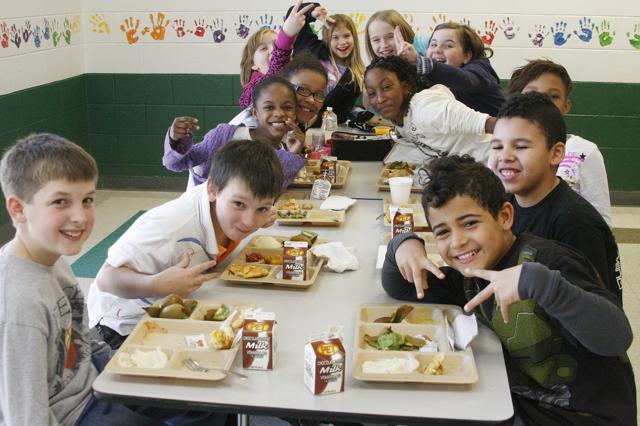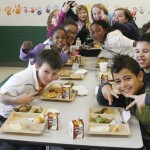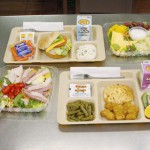- Trading root beer for rutabagas? Schools must meet USDA guidelines, stay on budget, yet strive to match what these Asheville third graders like to eat with what’s good for them. photos by Jonathan Welch
- Green is good: Kids do like food that’s green — like peas and green beans, says Haw Creek Elementary School Kitchen Manager Tim Pierce and some of the teachers who eat in the cafeteria too, and administrator Lynette Vaughn-Hensley.
How do you get more fruits and veggies on students’ plates that are already piled high with burgers and fries?
Start with baby steps, Xpress learned after eating with kids in a local elementary school, talking with school administrators like Lynette Vaughn-Hensley and quizzing restaurateur Laurey Masterton about her 2010 summer trip to the White House.
Masterton visited D.C. last year to learn about Michelle Obama’s Let’s Move campaign, an effort to encourage healthier youth through healthier lifestyles. Let’s Move calls for such initiatives as installing salad-bar equipment in elementary schools and putting chefs in front of students to help them learn about healthy food.
But when it comes to children’s health, say school officials, it pays to be realistic. Vaughn-Hensley, director of Child Nutrition Services for Buncombe County Schools, wonders how far the program’s proposed 5,000 salad bars will go toward improving children’s health. “I was wondering when I read that,” she says, “how many schools are there in the United States?”
At least 132,656 public and private elementary schools, according to data gathered by the U.S. Department of Education’s National Center for Educational Statistics (and those numbers are for the 2007-08 school year).
Vaughn-Hensley would love to see a chef in every school, she says. But in a school cafeteria, it may not be so easy matching a creative chef’s food ideas with U.S. Department of Agriculture guidelines for feeding children. “A chef lives in a world that is different,” she muses. In that world, food choices and presentations may be limited by no more than the chef’s imagination. But in the cafeteria kitchen, there are some limitations, she says, such as budget restrictions and the sheer volume of food that must be served. “Is it a great idea? Yes. Where I would recommend it is within the curriculum,” Vaughn-Hensley concludes.
And that’s where Masterton comes in. After her White House trip, the local business owner organized a Buncombe County chapter of the Chefs Move to Schools effort, a branch of Michelle Obama’s Let’s Move campaign. Masterton plans to facilitate the campaign’s goal to get chefs in local schools, where they can serve as mentors, says Masterton, and not get down and dirty with the school-lunch program. At present, local volunteer chefs are introducing the concept of wholesome, healthy foods to students.
And, as far as Masterton is concerned, it seems to be going quite well, despite all the inherent challenges.
"When I went to the White House in June, there was only one official pairing [between schools and chefs in Buncombe] — and that was me,” she says. The partnership with ASAP has since led to 15 solid pairings out of 30 schools, with more in the works, Masterton reports.
Under the program, chefs teach kids about foods that aren’t typically considered youth-friendly: squash, peas and turnips, for example. Contrary to popular belief, says Masterton, the kids seem quite receptive to the veggies and fruits presented to them. They’re also open to experimentation. Since the fall, almost 1,000 children have happily taken part in a cooking class, she adds.
"The wave of the future is to continue … getting all of the schools paired in the county and the city," she says. "What we're doing here is tiny, but we're trying to drive home the point that it's really not that hard. It's about making sure that kids see what real food is. And at least they get to mess with it a few times a year, which is not enough, but it's something."
And while people like Masterton and others are planting that seed on a local level, nationally the USDA is trying to implement changes to the school-lunch program, Vaughn-Hensley mentions. What they're proposing is an adjustment to what the cafeterias are serving to our nation's youth: Decrease the amount of potatoes and starchy vegetables; reduce sodium and, eventually, transfats; and increase the amount of fruits, vegetables and grains served.
While there’s no rush to yank the pizza and chicken nuggets from kids’ plates and replace them with kale and quinoa, there’s a ray of hope: Some of the kids might just get it.
Xpress visited a third-grade class at Haw Creek Elementary School in east Asheville as the kids chowed down in the cafeteria. We asked them what they already knew about food and how they would handle the sorts of changes to their eating habits that the USDA proposes. You’ll find many of their answers online at mountainx.com in a video we took that day.
But here are a few morsels: Some (mostly boys) preferred chicken nuggets to chewing celery. But most kids said that, as long as they had a variety of options, they were more than willing to trade a root beer for a rutabaga. (Well, maybe.)
That's good news, because (as many parents are well aware) in order to get kids to eat healthier, you’ve got to convince them that it tastes good too.
Here are some excerpted interview questions from our video with the cafeteria staff and kids (names were withheld by request of the school):
Mountain Xpress: What's your chief aim with serving the kids here?
Tim Pierce (kitchen manager): To give students what is healthy for them and to give them what they like, basically. I think our goal really is to give them healthy food and food that they like to eat.
And what do you think they mostly don't like to eat? Anything green?
Actually, they do like a lot of green. They like green beans and they love peas. They don't like things that are yellow, like squash.
One child said that she liked the cafeteria’s chicken nuggets, because they were baked and not fried, so they didn’t have so many “bad oils.” Some oils are bad, then?
Third-grade student: It depends on what kind; some are good for you and you need it; and some are bad, [so] you should kind of try to avoid it, like deep-fat frying versus baking it with a bunch of bread crumbs on it.
How do you know so much about good and bad fat?
My mom is kind of tight on that stuff. She worked here [at the school] and she would say, “Where's your protein?” and some of the kids would actually hold up their Popsicles that might have had frozen fruit in [them]. That's frozen fruit syrup over shaved ice, and they thought that was good for them. And sometimes even the potatoes are bad, because you cover them in sour cream or something. Potatoes are also just kind of a starch if you don't eat the skin.
Do you eat fast food?
One time me and my family went to [a local fast-food restaurant] two times in one day, and we felt horrible. Everyone gets that feeling like “Oh, I shouldn't have eaten that much … that is not what I needed, that was not at all good.”
Another nearby third-grade girl adds: That [fast] food, it tastes good at first because they put all the stuff on it, but once you wait a couple of minutes, it makes you feel really bad.
Do you drink chocolate milk?
I do sometimes, but not always. Because the chocolate milk has more sugar and more fat in it.
How do you know so much about good oils and bad oils?
We study it in school, and my mom is a nurse practitioner in training … There's the type of oil that comes from fish that's good for you, and there's the type of oil that's in a pan … it's grease. And that's not good for you because it makes you fat.
— Mackensy Lunsford can be reached at food@mountainx.com or 251-1333, ext. 107.







Before you comment
The comments section is here to provide a platform for civil dialogue on the issues we face together as a local community. Xpress is committed to offering this platform for all voices, but when the tone of the discussion gets nasty or strays off topic, we believe many people choose not to participate. Xpress editors are determined to moderate comments to ensure a constructive interchange is maintained. All comments judged not to be in keeping with the spirit of civil discourse will be removed and repeat violators will be banned. See here for our terms of service. Thank you for being part of this effort to promote respectful discussion.